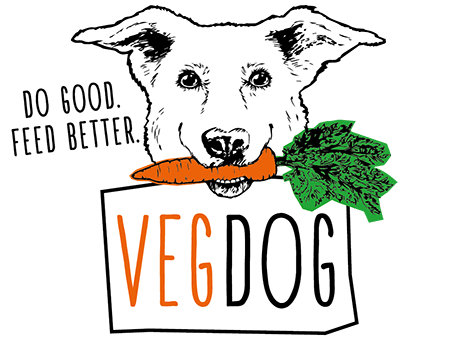
(ANIMAL) TESTING AND DOG FOOD - WHAT'S IT ALL ABOUT?
VEGDOG rejects animal testing and feeding trials due to the conditions in which the dogs are kept and instead relies on voluntary participation from dogs from private households. This way, the tolerance, digestibility and palatability are tested under animal-friendly conditions.
 Author: Carla Steffen
Author: Carla Steffen
 Proofreader: Veronika Hajek
Proofreader: Veronika Hajek
Updated: 01.10.2024
Published: 21.04.2023
Most dog owners only want the best for their dog - but not at the expense of other animals. The quality and composition of the food therefore plays a major role. But what actually happens before the ingredients even end up in the packaging? How is it checked whether the food tastes good and is well tolerated by the dog? In this blog post, we will look at various testing options.

When it comes to animal feed, there are basically two main types of experiments:
- Pure feeding trials or digestibility studies and
- animal testing
First, the definitions:
animal testing:
- According to the Animal Welfare Act, these are "interventions or procedures carried out for scientific purposes that cause pain, suffering or damage to the animals." Suffering is everything that goes beyond, for example, the prick of an injection needle. However, the term "suffering" also includes psychological aspects such as fear.
- In the area of animal nutrition, animal testing was carried out more intensively, especially at the beginning of nutritional research, for example to determine the requirement values for various nutrients. These nutrients were fed in different amounts and compositions in order to research the optimal daily intake for each animal species. Depending on the question, sampling can include urine, feces and blood samples or sometimes even require interventions. The requirement figures determined in this way have since been used to calculate nutrient levels in feed or to calculate individual rations (e.g. NRC1 and FEDIAF2).
What must be distinguished from animal testing are so-called feeding trials or digestibility studies:
- Primary objectives of feeding trials or digestibility studies are:
- Palatability (= taste of the food)
- Digestibility (how much of each nutrient is absorbed from the feed, e.g. protein)
- Tolerability (are the ingredients well tolerated by the dog?)
-> In a classic feeding experiment, urine and feces samples are necessary. - Feeding trials are carried out by some feed companies in their own test centers. The dogs are usually housed in groups in large kennels.
- At certain times during a feeding experiment, the dogs are separated from the group so that the food can be distributed individually and separate stool samples can be collected. This means that the dogs are usually kept individually in kennels for several days at a time. They are also walked individually for urine samples, and there is usually only visual and auditory contact with the group.
- Most dogs spend several years in these facilities. On average, they are then given to private households at the age of 5-6 years. Sick animals or animals that are not suitable for feeding trials for other reasons are usually given away earlier. In some cases, however, dogs can remain in the so-called test centers until they are very old, as seniors are also needed for examinations.
- In general, there are guidelines for feed trials, which are drawn up in the EU, for example by FEDIAF: FEDIAF Nutritional Guidelines_2018_deutsch.indd (ivh-online.de)
- Even with this type of experiment, it cannot be ruled out that the dogs experience stress due to their conditions.

Basically, two types of experiments can be distinguished: animal experiments and feeding experiments. Even if no blood samples or other interventions are taken during a feeding experiment, VEGDOG rejects these due to the conditions in which the animals are kept, just like traditional animal experiments. Of course, we do not carry out any animal experiments on our products.
In order to continue to investigate the digestibility, palatability and tolerance of feed in the future, feeding trials under controlled conditions are necessary, particularly in order to further develop purely plant-based feed.

Instead of dogs from scientific institutions, dogs from private households can participate on a voluntary basis. This requires a little more effort, as the owners' cooperation and reliability are required in order to obtain meaningful results. At the beginning of a feeding study, the owners can therefore be trained by specialist staff to collect samples and receive professional support throughout the rest of the study. As in many areas, practice makes perfect - so it can make sense to work with an established customer base over the long term.
At VEGDOG, the two- and four-legged team members are happy to take on the job of the first taste test. If this is positive, it goes on to the next round: the practical test with volunteers from our customer base. Of course, the food samples are tested for safety before such tests.
Because VEGDOG is against any kind of animal suffering, we support alternative methods and donated to Doctors Against Animal Testing on Black Friday 2022. Together with your help, we even exceeded our donation goal of 10,000 euros: together with you, we raised 18,485€! We say THANK YOU, especially on behalf of the animals!
Sources
1 National Research Council. 2006. Nutrient Requirements of Dogs and Cats . Washington, DC: The National Academies Press. https://doi.org/10.17226/10668.
2 https://europeanpetfood.org/self-regulation/nutritional-guidelines/
Share








